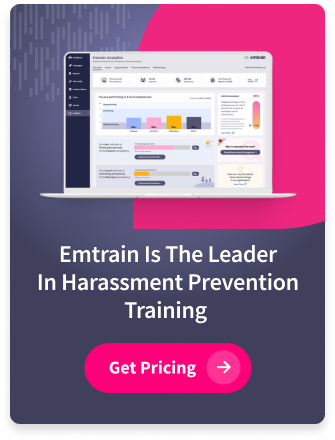In an environment of heightened regulatory scrutiny and escalating enforcement actions, compliance leaders face a persistent challenge: translating policy into practice. Training programs are deployed, policies are distributed, and reporting mechanisms are established—but does any of it actually change employee behavior?
Our 2025 data provides a rare piece of good news: organizations achieved a 25% reduction in unhealthy accountability behaviors, with positive improvements across all major areas of business compliance. Findings are drawn from responses to questions embedded in Emtrain HR compliance training, asking employees about the behaviors they see from their co-workers, managers, and leadership. Because compliance training is mandatory in many organizations, response rates are very high, providing a highly reliable indicator of actual workplace conditions.
For compliance officers, general counsel, and risk management leaders navigating an increasingly complex regulatory landscape, this data reveals progress worth celebrating.
Welcome to the fourth installment of our 2026 Workplace Culture Report series, where we examine the accountability gains organizations have achieved—and the critical next steps for sustaining compliance effectiveness in 2026.
The Regulatory Context: Why Accountability Matters More Than Ever
The past several years have intensified compliance complexity across multiple domains:
Global Data Privacy
Following the EU’s General Data Protection Regulation (GDPR) implementation in 2018, jurisdictions worldwide have enacted comprehensive privacy frameworks. The California Consumer Privacy Act (CCPA), China’s Personal Information Protection Law (PIPL), and similar legislation across U.S. states create a patchwork of requirements. Organizations face not only operational compliance burdens but significant financial penalties—as of January 2025, GDPR fines cumulatively had totaled €5.8 billion, with individual violations reaching hundreds of millions.
Cybersecurity
With ransomware attacks increasing in frequency and sophistication, regulatory bodies have responded with mandatory disclosure requirements and security standards. The SEC’s 2023 cybersecurity rules require public companies to disclose material incidents within four business days and provide annual reporting on cybersecurity governance. Employee behavior remains the weakest link, with phishing and social engineering tactics exploiting human vulnerabilities despite technological controls.
Conflicts of Interest and Third-Party Risk
Anti-bribery and corruption enforcement continues at elevated levels globally. The U.S. Foreign Corrupt Practices Act (FCPA), U.K. Bribery Act, and similar statutes create extraterritorial obligations. Third-party relationships—particularly with agents, consultants, and distributors—represent the highest risk category for FCPA violations, requiring robust due diligence and monitoring.
Antitrust and Competition Law
Antitrust enforcement has intensified under both U.S. and EU competition authorities, with particular scrutiny on digital markets, mergers, and information exchanges. Even inadvertent information sharing between competitors can trigger investigations, making employee awareness of antitrust boundaries critical.
In this environment, effective compliance isn’t merely about policies—it’s about embedding behavioral norms that reduce risk before incidents occur.
The Accountability Gains: What the Data Shows
Emtrain’s analysis reveals systematic improvements across the compliance landscape:
Bribery Risk: Reduced Tolerance for Shortcuts
+4.55% improvement in employees reporting that co-workers would not overlook actions that create bribery risk under business pressure.
Why this matters: This metric directly measures whether compliance standards hold under real-world pressure—the ultimate test of program effectiveness. The improvement indicates stronger ethical culture, not just awareness.
Cybersecurity: Peer Accountability and Leadership Reinforcement
+2.53% improvement in willingness to address risky digital behavior among colleagues
+2.11% improvement in manager reinforcement of collective cybersecurity responsibility
Why this matters: Technical controls are necessary but insufficient. When employees view cybersecurity as a shared responsibility and feel empowered to address risky behavior, organizations create a human firewall that complements technological defenses.
Third-Party Misconduct: Increased Scrutiny
+2.28% improvement in employees reporting they would not ignore third-party misconduct if the party was delivering results.
Why this matters: Third-party relationships create significant FCPA and reputational risk. This improvement suggests stronger awareness that results never justify compliance violations—a critical cultural shift.
Gifts and Gratuities: Enhanced Visibility and Control
+5.72% improvement in employee confidence regarding management visibility and accountability for business gifts given and received.
Why this matters: Gift and entertainment policies are foundational to anti-corruption compliance. Improved confidence in monitoring systems suggests organizations have successfully implemented controls that employees recognize and trust.
Speak-Up Culture: Strengthened Reporting Confidence
+2.20% improvement in comfort reporting compliance concerns
+1.72% improvement in confidence reporting without personal negative impact
+1.27% improvement in comfort reporting workplace violence concerns
Why this matters: Early detection depends on employees’ comfort reporting concerns. These gains suggest organizations have invested in creating credible reporting mechanisms and non-retaliation protections. This information gives compliance leaders critical time to investigate and resolve potential issues before they become costly errors.
The Implementation Success: What’s Working
These improvements didn’t happen by accident. Organizations have made substantial investments in compliance infrastructure:
Training Programs: Mandatory, annual compliance training with high completion rates that teaches expected behavior in real-world situations ensures consistent baseline knowledge across the workforce.
Reporting Systems: Anonymous hotlines, multiple reporting channels, and clear escalation procedures provide accessible mechanisms for raising concerns.
Remediation Processes: Investigation protocols and disciplinary consistency demonstrate that reports lead to action, building credibility in the system.
Leadership Messaging: Regular reinforcement from managers—particularly in cybersecurity—embeds compliance as an operational priority, not just a legal obligation.
Monitoring and Controls: Enhanced visibility into high-risk activities (gifts, third-party relationships) through technology-enabled systems creates both deterrence and detection capabilities.
These systematic approaches have successfully translated compliance requirements into behavioral expectations, creating the 25% reduction in unhealthy accountability across our client base.
The Remaining Gap: Where Vulnerability Persists
Despite these gains, one critical metric declined:
-0.39% decline in employee perception that leaders have implemented structures necessary to keep the organization safe.
While modest, this finding warrants attention. It suggests a potential disconnect: employees recognize improved behavioral norms, but warn that organizational structures don’t fully support sustained compliance.
Potential reasons:
- Resource constraints: Adequate structures may exist but feel understaffed or under-resourced
- Complexity overload: Proliferating requirements may create perception that organizations are perpetually behind
- Visibility gaps: Structural improvements at the executive level may not be visible to frontline employees
- Integration challenges: Point solutions for specific compliance domains may lack cohesive integration
Potential risk: If employees don’t believe organizational structures can sustain current behavioral improvements, those improvements may erode under pressure.
The Opportunity: From Reactive Compliance to Proactive Risk Management
Organizations have successfully cleared the immediate hurdles of recent regulatory requirements. The challenge now is sustaining compliance effectiveness.
Moving Beyond Incident Response
Traditional compliance programs focus heavily on responding to breaches, investigations, and violations. While necessary, this reactive stance is costly in time, resources, and executive attention—precisely what leaders focused on business transformation cannot afford.
The alternative: Proactive monitoring of leading indicators to prevent incidents before they occur.
Leveraging Behavioral Data as Leading Indicators
The data points that improved in 2025 represent leading indicators of compliance risk:
- Declining tolerance for bribery shortcuts predicts lower FCPA risk
- Increased willingness to address cyber risks predicts fewer breaches
- Stronger third-party scrutiny predicts reduced vendor-related violations
- Improved speak-up confidence predicts earlier problem detection
Organizations that continuously monitor these behavioral indicators can identify emerging risks before they manifest as reportable incidents, regulatory violations, or reputational crises.
Building Predictive Compliance Programs
The next evolution of compliance effectiveness involves:
- Continuous Behavioral Monitoring
Measure compliance culture indicators, enabling real-time visibility into risk areas. - Predictive Analytics
Identify patterns that precede compliance failures—declining speak-up confidence in specific business units, erosion of accountability under quarterly pressure, etc. - Targeted Interventions
Enable compliance managers to work tactically, building more stringent mechanisms in departments or locations where data shows policies are likely to be ignored and employees are reluctant to report concerns. - Integration with Risk Management
Connect behavioral compliance data with operational risk frameworks, providing holistic visibility for executive decision-making and independent oversight from Board Audit Committees. - Structural Reinforcement
Address the perception gap by visibly investing in sustainable compliance infrastructure—adequate staffing, technology integration, and clear escalation pathways.
Sustaining Progress: Recommendations for 2026
To maintain the accountability gains achieved and address remaining vulnerabilities, compliance leaders should consider:
Maintain training rigor: The training that generated this data is working. Sustain investment in quality content and consistent deployment.
Integrate predictive behavioral data into ERM: Ensure enterprise risk management processes incorporate leading behavioral indicators alongside traditional risk metrics.
Strengthen manager enablement: Given the positive impact of manager reinforcement (particularly in cybersecurity), enable managers to inspire compliance across all areas, and encourage speaking up as part of team culture.
The Bottom Line: Progress With Purpose
The 25% reduction in unhealthy accountability behaviors represents genuine progress in an environment where such victories are rare. Organizations have successfully implemented compliance systems that translate policy into practice, creating behavioral norms that reduce regulatory and reputational risk.
For executives focused on driving business transformation, this progress should be welcome news: compliance is becoming less of a distraction and more of a stable foundation. Fewer breaches, investigations, and remediation crises mean more bandwidth for strategic initiatives.
However, the slight decline in confidence regarding organizational structures signals that this progress is not guaranteed to persist. Sustaining compliance effectiveness requires continued investment in infrastructure, proactive monitoring, and visible leadership commitment.
The opportunity for 2026 is clear: organizations that leverage their accountability gains as a platform for predictive compliance programs will not only reduce risk but create competitive advantages through operational resilience and stakeholder trust.
Take Action: Build on Your Compliance Momentum
The accountability improvements documented in our data represent significant organizational achievement. The question is whether you’ll sustain and build on this progress—or whether gains will erode without continued focus.
Access comprehensive compliance culture insights:
- Access training that teaches expected behavior in real-world situations
- Activate your Code of Conduct document through online training on its key elements
- Benchmark your organization’s accountability metrics against industry data
- Use tools to view compliance leading indicators by department or location
Transform compliance from cost center to competitive advantage.








